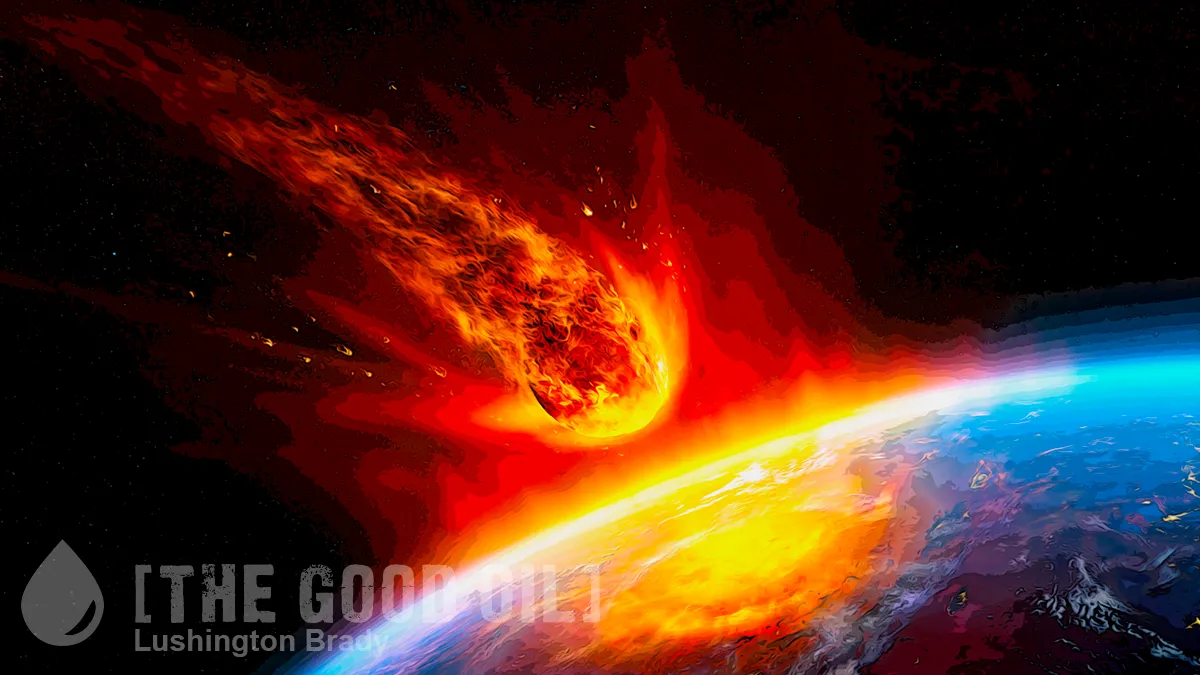It’s been a staple of science fiction, especially since we realised that it likely wiped out the dinosaurs: the terror of a cosmic body smashing into the Earth. Just as staple is the idea – the hope – that human ingenuity will save at least some of us from Armageddon. When Worlds Collide (1951) took the rather pessimistic view that the only hope of survival was fleeing Earth altogether. Meteor (1979) and Armageddon (1998) took a different tack: destroy the cosmic villain before it destroys the Earth (using nuclear weapons, of course, because, as any SF hack writer knows, nukes fix everything).
This is more than just SF fantasizing, though. In 1908, what is thought to be a comet (or fragment thereof) blasted hundreds of kilometres of remote taiga forest in Tunguska, Russia. More recently, modest-sized (say, just a few metres) space rocks have rattled windows. Scientists and governments are accordingly working on ‘planetary defence’ systems, such as deflecting cosmic bodies. The 2022 Double Asteroid Redirection Test, or DART mission, crashed an uncrewed spacecraft into a distant asteroid and showed that it is possible to deflect asteroids.
There is, however, a huge caveat to this technique: we can’t deflect asteroids if we don’t know where they are. That’s why planetary defence is a tag team effort. While space agencies are building spacecraft and developing technology to deflect (or destroy) incoming asteroids, others have their eyes on the sky, seeking any near-Earth asteroids that may imperil us.
The earlier a threatening asteroid can be detected, the better. Even a small nudge will, over cosmic time and distance, turn into a large orbit change. The closer a threat gets to Earth, the bigger the nudge needed.
At the moment, Earth’s continued safety relies on optical astronomy: telescopes that look for sunlight glinting off space rocks that have yet to be discovered. Many observatories conduct all sorts of astronomical quests; finding asteroids is something that happens opportunistically during those surveys. Some telescopes, including a select few funded by Nasa, are solely dedicated to finding errant asteroids.
This method of space rock sleuthing has proved fairly effective, especially for the heftier asteroids. Nasa estimates that most of the planet killers – asteroids a kilometre long or above – zooming about near Earth’s orbit around the sun have been found. (The asteroid that swiftly ended the reign of the non-avian dinosaurs 66 million years ago was 10km long, and easily fits into the planet killer category.) It also suspects it has spotted just under half of those 140m, near-Earth, city-killer-size asteroids. (And, thankfully, none of them are on a collision course with Earth.)
The problems should be immediately obvious: ‘just under half’ means that more than half are still out there undetected. That’s just the really big ones. It’s estimated that there are roughly 14,000 near-Earth asteroids with city-flattening potential still undetected.
Another problem is that not all asteroids are the same and some are much harder to see. Metallic asteroids are shiny and tend to stand out but asteroids that are more ‘dirty’? Not so much. And, asteroids orbiting nearer the Sun are hidden in its glare.
Enter two new asteroid-detectors.
The first is Nasa’s Near-Earth Object Surveyor, or NEO Surveyor, mission. It’s essentially a sniper that is going to be hidden in outer space. Within 10 years of being launched, it will find 90% or more of those city-killer asteroids that have yet to be found by conventional means […] Nasa recently gave the green light to begin building it. Its secret sauce comes from the fact that, instead of using reflected starlight to find asteroids, it’s going to seek out their heat signatures […]
Sitting far from Earth, and covered in a sun shield, it will be one of the coldest objects ever built. And that allows its infrared eye to be extremely sensitive to any heat sources, including those of city-killer asteroids warmed by the sun. It will be so perceptive that even asteroids concealed by the sun’s glare will quickly show up on its scopes.
NEO Surveyor will be launched within the next five years.
Meanwhile, on Earth, the Vera C Rubin Observatory, under construction now in the mountains of Chile, while not a dedicated asteroid hunter, is ideal for finding lurking rocks in space.
It has the most technologically advanced mechanical eye ever made. With a colossal mirror that collects even the faintest, most distant starlight, and a 3,200-megapixel digital camera the size of a car, it will see and chronicle anything that moves in the dark sky above, from distant exploding stars to interstellar comets.
It will also create a detailed inventory of pretty much everything in the solar system, including the host of objects flying around close to our planet. The first asteroid was spotted in 1801, and it took two centuries to find a million more. In the first six months of operations, which begin in 2025, Rubin will double that number. It is, in other words, a polymathic telescope; one that, among all its other tasks, will find asteroids of all shapes and sizes faster than any other spotter on Earth.
And, for the first time in Earth’s history, its inhabitants will be in a position to do something to avert a cosmic catastrophic event.









